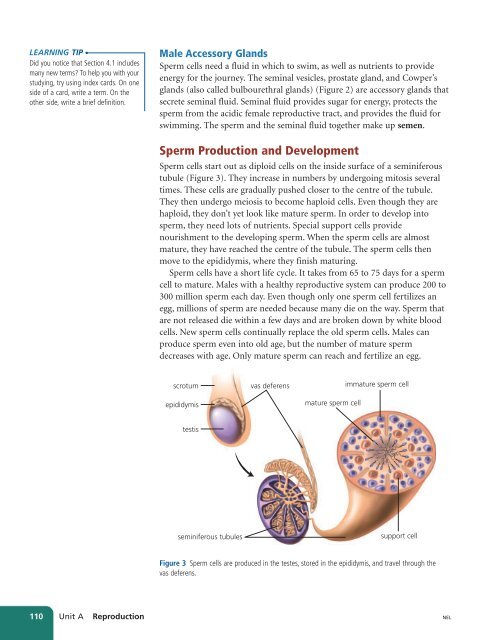Unit A Reproduction
Unit A Reproduction
Unit A Reproduction
You also want an ePaper? Increase the reach of your titles
YUMPU automatically turns print PDFs into web optimized ePapers that Google loves.
LEARNING TIP<br />
Did you notice that Section 4.1 includes<br />
many new terms? To help you with your<br />
studying, try using index cards. On one<br />
side of a card, write a term. On the<br />
other side, write a brief definition.<br />
Male Accessory Glands<br />
Sperm cells need a fluid in which to swim, as well as nutrients to provide<br />
energy for the journey. The seminal vesicles, prostate gland, and Cowper’s<br />
glands (also called bulbourethral glands) (Figure 2) are accessory glands that<br />
secrete seminal fluid. Seminal fluid provides sugar for energy, protects the<br />
sperm from the acidic female reproductive tract, and provides the fluid for<br />
swimming. The sperm and the seminal fluid together make up semen.<br />
Sperm Production and Development<br />
Sperm cells start out as diploid cells on the inside surface of a seminiferous<br />
tubule (Figure 3). They increase in numbers by undergoing mitosis several<br />
times. These cells are gradually pushed closer to the centre of the tubule.<br />
They then undergo meiosis to become haploid cells. Even though they are<br />
haploid, they don’t yet look like mature sperm. In order to develop into<br />
sperm, they need lots of nutrients. Special support cells provide<br />
nourishment to the developing sperm. When the sperm cells are almost<br />
mature, they have reached the centre of the tubule. The sperm cells then<br />
move to the epididymis, where they finish maturing.<br />
Sperm cells have a short life cycle. It takes from 65 to 75 days for a sperm<br />
cell to mature. Males with a healthy reproductive system can produce 200 to<br />
300 million sperm each day. Even though only one sperm cell fertilizes an<br />
egg, millions of sperm are needed because many die on the way. Sperm that<br />
are not released die within a few days and are broken down by white blood<br />
cells. New sperm cells continually replace the old sperm cells. Males can<br />
produce sperm even into old age, but the number of mature sperm<br />
decreases with age. Only mature sperm can reach and fertilize an egg.<br />
scrotum<br />
epididymis<br />
vas deferens<br />
mature sperm cell<br />
immature sperm cell<br />
testis<br />
seminiferous tubules<br />
support cell<br />
Figure 3 Sperm cells are produced in the testes, stored in the epididymis, and travel through the<br />
vas deferens.<br />
110 <strong>Unit</strong> A <strong>Reproduction</strong><br />
NEL

















